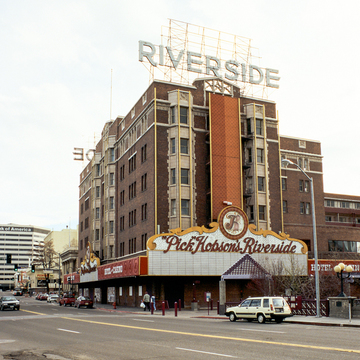George Wingfield, one of Nevada's most prominent early twentieth-century financial figures, built the Riverside Hotel next to the county courthouse to accommodate people seeking divorces. Having made his money during the Tonopah and Goldfield booms, Wingfield turned his attention to other aspects of Nevada's economy. Viewing the divorce industry as a potential gold mine, he successfully lobbied the state legislature in 1927 to reduce the residency requirement from six to three months.
The six-story brick building has simplified Gothic details in cream terra-cotta, such as pointed-arched windows on the sixth floor, traceried parapets, and stacked bay windows embellished with panels and quoins. Although much of the rest of the exterior remains intact, the original storefronts at street level were bricked in during alterations in 1950–1951 to allow expansion of the main casino. The interior was virtually gutted after the legalization of gambling in 1931 fostered installation of the casino. In the 1950s DeLongchamps and his partner at that time, Frank W. Green, designed a large casino-restaurant-theater wing (demolished 1997) to the west of the original T-shaped structure. After standing vacant for several years and nearly being demolished, the Riverside was rehabilitated in 1999–2000 to accommodate retail space on the ground floor and artists' studios on the upper floors. This adaptive reuse project may signal a shift in the city's attitude toward preserving its historic buildings.












